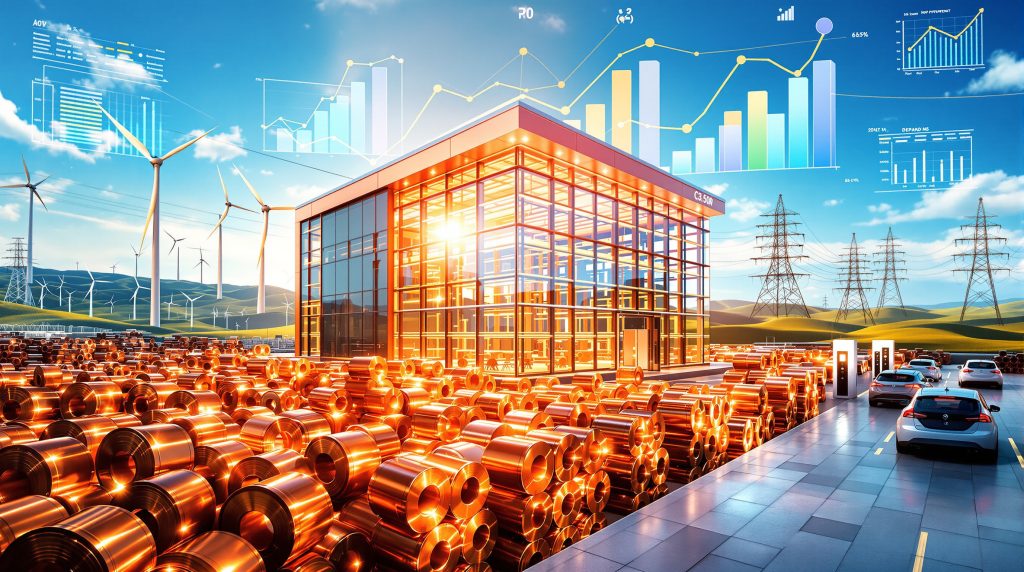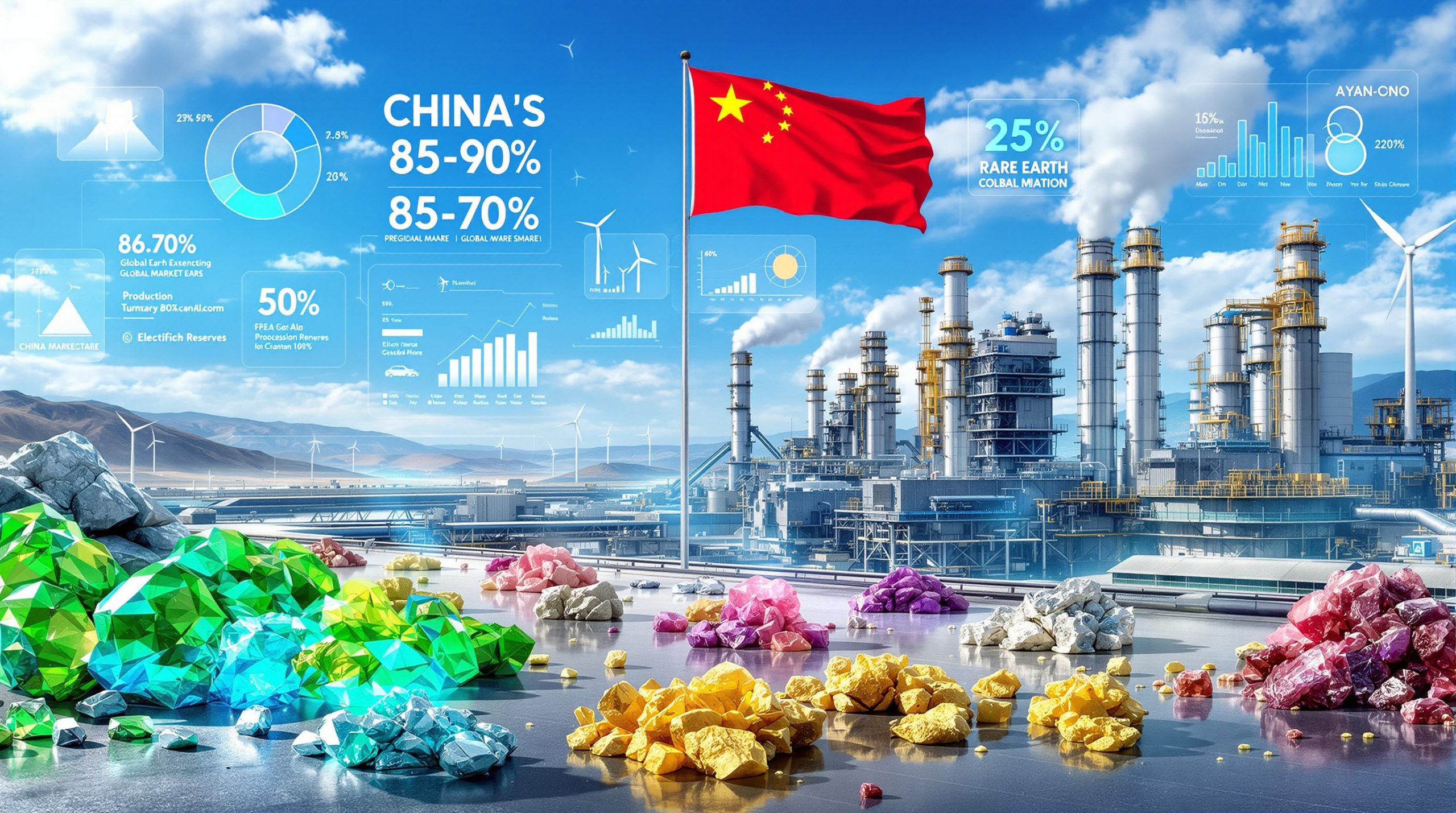Understanding Copper's Critical Role in Modern Technology
Copper's exceptional electrical conductivity positions it as the backbone of modern electrical systems. As the world's second-most conductive metal, copper achieves approximately 99.3% efficiency in electrical transmission, trailing only silver's 99.7% efficiency. This marginal difference becomes crucial when considering cost-effectiveness, as silver commands roughly $48 per ounce compared to copper's $5 per pound.
Alternative materials like aluminum demonstrate significantly lower performance, operating at approximately 93% efficiency. This efficiency gap translates directly into heat generation, creating safety concerns that make aluminum unsuitable for residential wiring and high-performance applications. The relationship between conductivity and safety explains why copper remains the dominant choice for electrical infrastructure worldwide.
The Foundation of Digital and Clean Energy Infrastructure
Modern technological advancement relies fundamentally on copper's unique properties for reliable electricity transmission. Currently, 95% of global copper consumption relates directly to electrification applications, from residential wiring systems to industrial power networks. This universal dependence positions copper demand in AI and electrification as an essential factor for both artificial intelligence infrastructure and renewable energy systems.
The metal's superior conductivity, combined with excellent corrosion resistance and workability, makes it irreplaceable in applications requiring long-term reliability. Unlike alternative materials that may degrade or create connection issues over time, copper maintains consistent performance across decades of operation.
How AI Data Centers Are Transforming Copper Consumption Patterns
The Power-Intensive Nature of AI Computing
Artificial intelligence operations create unprecedented electrical infrastructure demands that dwarf traditional computing requirements. AI server racks consume between 30-80 kilowatts per rack, representing a dramatic increase from conventional data center specifications. This power density surge necessitates extensive copper-based infrastructure for power delivery, cooling systems, and electrical connections.
The competitive landscape driving AI development has created an environment where speed and capability override cost considerations. Furthermore, major technology companies view AI infrastructure investment as existential, prioritising rapid deployment over traditional cost-benefit analyses.
Quantifying AI's Copper Requirements
Table: AI Data Center Copper Consumption Projections
| Year | Annual Copper Demand (Tonnes) | Cumulative Demand (Tonnes) |
|---|---|---|
| 2025 | 350,000 | 350,000 |
| 2028 | 572,000 | 1,750,000 |
| 2030 | 480,000 | 2,900,000 |
| 2035 | 400,000 | 4,300,000+ |
The intensity of competition between technology giants has fundamentally altered traditional infrastructure investment patterns. Companies like Meta, Google, and Microsoft approach AI development as a winner-takes-all scenario, driving continuous expansion regardless of material costs. This approach represents a paradigm shift from traditional data centre economics.
Architectural Differences in AI Facilities
In addition, AI-powered data centres require 2-3 times more copper per square metre compared to traditional facilities. This increased demand stems from several architectural necessities:
- Enhanced power distribution systems designed for high-density computing loads
- Advanced cooling infrastructure utilising copper heat exchangers for thermal management
- Redundant electrical pathways ensuring uninterrupted AI operations
- Specialised connectors and bus bars capable of handling increased electrical loads
The race between companies and nations to establish AI dominance has created a scenario where infrastructure buildout cannot be delayed due to material availability constraints. Consequently, this dynamic fundamentally alters traditional supply-demand relationships in the copper market.
What Makes Electrification a Copper Demand Driver?
The Electric Vehicle Revolution
Electric vehicles represent one of the most significant transformations in copper consumption patterns across the transportation sector. Each EV requires approximately 82 kilograms of copper, representing nearly four times more than internal combustion engine vehicles. Furthermore, EVs transforming mining transportation demonstrates how this copper serves multiple critical functions:
- Electric motors with extensive copper windings for electromagnetic induction
- Battery systems requiring copper connections and thermal management
- Charging infrastructure demanding extensive copper wiring networks
- Power electronics including inverters and converters for energy conversion
The transition extends beyond individual vehicles to encompass entire charging networks, requiring substantial copper infrastructure for power distribution and grid connections.
Renewable Energy Infrastructure Requirements
The global shift toward sustainable energy sources creates massive copper demand across multiple applications. Wind power systems require 2.5 to 6.4 tonnes of copper per megawatt of generating capacity, primarily in generators and transmission systems. Solar photovoltaic installations demand 2.8 to 4.8 tonnes of copper per megawatt, concentrated in extensive wiring systems and power conversion equipment.
Wind Power Systems:
- Copper-intensive generators utilising electromagnetic principles
- Transmission systems connecting turbines to electrical grids
- Grid connection infrastructure requiring substantial copper content
Solar Photovoltaic Installations:
- Extensive wiring networks connecting individual panels
- Inverter systems converting DC to AC power for grid compatibility
- Grounding systems ensuring electrical safety
Grid Modernisation Challenges
Electrification requires comprehensive electrical grid upgrades to accommodate increased power flows and renewable energy integration. Modern smart grids demand copper-based sensors, controls, and enhanced transmission capacity using copper conductors. Moreover, energy storage systems, essential for renewable energy integration, require extensive copper connections for battery management and power conversion systems.
The decentralised nature of renewable energy generation, compared to traditional centralised power plants, necessitates more extensive distribution networks serving new electrical loads across wider geographic areas.
Why Traditional Supply Chains Cannot Meet Rising Demand
The Mining Industry's Conservative Approach
Following previous commodity cycles where aggressive expansion strategies resulted in executive turnover and shareholder losses, mining companies have adopted notably cautious growth approaches. Industry observers note that approximately 15 of the top 20 CEOs of major mining companies were replaced following the last commodity supercycle, creating institutional memory favouring conservative expansion.
This risk-averse environment focuses on:
- Brownfield expansions extending existing operations rather than developing new mines
- Risk-averse capital allocation avoiding large-scale greenfield investments
- Incremental capacity additions rather than transformational projects
- Extended feasibility studies prioritising certainty over speed
Declining Ore Grades and Aging Infrastructure
Global copper mining faces structural challenges that fundamentally limit supply growth potential. Average ore grades continue declining across existing operations, requiring increased material processing for equivalent copper production. Additionally, approximately 35% of the world's largest copper mines commenced operations over 100 years ago, representing aging infrastructure with increasing operational complexity.
The progression toward deeper, more remote deposits has extended development timelines significantly. Modern copper projects require 10-20 years from discovery to production, creating substantial delays between demand recognition and supply response.
The Discovery Gap
The mining industry has discovered significantly fewer large-scale copper deposits in recent decades compared to historical patterns. Only five to six major copper projects have achieved completion over the past decade, whilst exploration success rates continue declining. This discovery gap creates long-term supply constraints that cannot be rapidly addressed through conventional mining approaches.
The industry faces an unprecedented challenge: meeting projected copper demand will require mining more copper over the next 30 years than has been extracted throughout human history.
How Geopolitical Factors Amplify Copper Demand Pressures
Supply Chain Diversification Imperatives
Growing geopolitical tensions have highlighted critical vulnerabilities in concentrated copper supply chains. With China controlling approximately 60% of global copper processing capacity, Western nations are prioritising supply chain diversification strategies. This shift toward "friend-shoring" creates additional demand pressures as countries develop parallel processing capabilities.
The strategic importance of copper has elevated it to a resource comparable to oil in geopolitical significance. Nations increasingly recognise that controlling copper supply chains provides substantial economic and technological advantages in an electrified economy.
Strategic Resource Competition
Current geopolitical dynamics reflect broader competition over critical materials essential for technological advancement. The breakdown of globalised supply chains has created inefficiencies that ultimately increase demand for raw materials. As supply chains become less efficient but more secure, the value of underlying copper assets increases proportionally.
This trend manifests through:
- National stockpiling programmes creating additional demand beyond immediate industrial needs
- Investment in domestic processing capacity despite higher operational costs
- Trade policy considerations affecting global copper flows and pricing
- Technology transfer restrictions impacting efficiency gains in processing
What Does Future Copper Demand Look Like?
Projected Growth Scenarios
Industry analysis projects substantial increases in global copper demand in AI and electrification applications, driven by multiple converging technological trends. Traditional copper applications, whilst continuing to grow, will be overshadowed by new demand categories. However, copper price insights suggest market volatility ahead.
Table: Global Copper Demand Projections by Sector
| Demand Driver | 2024 Demand | 2030 Projection | 2050 Projection |
|---|---|---|---|
| Traditional Uses | 22 million tonnes | 24 million tonnes | 26 million tonnes |
| Electrification | 3 million tonnes | 8 million tonnes | 18 million tonnes |
| AI Data Centers | 0.3 million tonnes | 0.8 million tonnes | 3.5 million tonnes |
| Total Demand | 25.3 million tonnes | 32.8 million tonnes | 47.5 million tonnes |
The Emerging Market Electrification Wave
Developing economies, particularly across Asia and Africa, are experiencing rapid electrification as populations transition from poverty to middle-class status. This demographic shift mirrors China's industrialisation period from 2005-2010, when sustained copper demand growth accompanied massive economic development.
India represents a particularly significant growth driver, with its large population beginning widespread electrification simultaneously with global AI infrastructure expansion. This creates unprecedented simultaneous demand pressures from both developed and developing economies.
Investment Implications
The copper supply-demand imbalance creates significant investment opportunities across the entire value chain. Mining equity valuations increasingly reflect supply scarcity premiums, whilst infrastructure development projects require substantial capital investment. For instance, technology innovation in extraction and processing methods becomes increasingly valuable as ore grades decline and operational complexity increases.
Recycling initiatives represent growing value propositions as primary supply constraints tighten. Enhanced copper recycling could potentially provide 25-30% of future copper supply through improved collection and processing technologies.
Which Regions Will Drive Future Copper Consumption?
Asia-Pacific Electrification Trends
The Asia-Pacific region continues driving global copper demand in AI and electrification applications through sustained economic development and technological adoption. Countries experiencing rapid industrialisation require extensive electrical infrastructure development, creating sustained copper consumption growth similar to historical patterns observed during China's economic transformation.
North American Technology Infrastructure
Advanced economies in North America drive copper demand through AI infrastructure deployment across major technology hubs. Government incentives supporting electric vehicle adoption, renewable energy mandates requiring grid modernisation, and industrial automation increasing electrical intensity all contribute to sustained demand growth.
The competitive dynamics between technology companies, nations, and regions create demand patterns that transcend traditional economic cycles, as participants view copper access as strategically essential rather than economically optional.
How Can Supply Chains Adapt to Growing Demand?
Recycling and Circular Economy Solutions
Enhanced copper recycling represents a critical supply source with potential to provide substantial portions of future copper requirements. Improved collection and processing technologies could reduce environmental impact compared to primary mining whilst serving regional demand centres through shorter supply chains.
Technology innovations in separation and purification methods continue advancing recycling efficiency, making previously uneconomical recycling operations financially viable. The circular economy approach becomes increasingly attractive as primary ore grades decline and mining operations become more complex.
Mining Technology Advancement
Technological innovations may unlock previously uneconomical copper resources through advanced extraction methods. In-situ leaching techniques could access lower-grade deposits that conventional mining approaches cannot economically process. Moreover, AI in mining innovation enables deep-sea mining technologies that might access ocean floor resources, though environmental and regulatory challenges remain significant.
Biotechnology applications in ore processing could improve efficiency in extracting copper from complex mineral assemblages. Automation systems continue reducing operational costs whilst improving safety and environmental performance in mining operations.
What Are the Economic Implications of Copper Scarcity?
Price Volatility and Market Dynamics
Copper's structural supply-demand imbalance creates conditions for significant price volatility as market participants navigate competing forces. Short-term demand fluctuations driven by economic cycles interact with long-term structural deficits supporting elevated price levels. Furthermore, New York copper prices demonstrate how geopolitical premiums increasingly influence pricing as supply chain security concerns override purely economic considerations.
The commodity has earned the nickname "Dr. Copper" due to its strong correlation with global economic health, though current dynamics suggest this relationship may be evolving as strategic considerations become more prominent.
Industrial Cost Pressures
Rising copper costs create cascading effects across multiple industries dependent on the metal. Construction sectors face higher material costs for electrical systems and plumbing infrastructure. Electronics manufacturing requires design optimisation to minimise copper content whilst maintaining performance standards.
The automotive industry must manage EV production expenses as copper content increases dramatically compared to traditional vehicles. Renewable energy projects evaluate economic viability as material costs influence overall project economics and financing arrangements.
Near-Surface Advantages and Infrastructure Development
Surface Proximity Benefits
Mining operations benefit significantly from deposits located near the surface compared to deep underground resources. Surface-accessible deposits require substantially lower capital investment and shorter development timelines. Projects like Resolution Copper, despite containing massive resources, face minimum 7-year development timelines due to extreme depth requirements and associated infrastructure complexity.
Near-surface deposits offer multiple advantages:
- Reduced capital requirements for mine development and infrastructure
- Shorter development timelines enabling faster response to market demand
- Lower operational costs through simplified extraction processes
- Improved safety profiles with reduced underground operational risks
Strategic Infrastructure Location
Geographic location significantly influences project economics and development feasibility. Projects located near existing infrastructure networks benefit from substantial cost advantages compared to remote locations requiring extensive new infrastructure development.
Key infrastructure considerations include:
- Power transmission access reducing electrical infrastructure investment requirements
- Transportation networks facilitating material movement and workforce access
- Port facilities enabling efficient product shipping to global markets
- Population centres providing workforce availability and reducing camp construction needs
Projects located within 10 kilometres of major transmission lines, national road systems, and established ports demonstrate significantly improved economic profiles compared to remote locations requiring comprehensive infrastructure development.
Metallurgical Recovery and Processing Efficiency
Recovery Rate Optimisation
Metallurgical testing reveals significant variations in copper recovery rates across different deposit types and processing methods. Advanced deposits demonstrate 95% recovery rates compared to industry assumptions of 75% recovery, substantially improving project economics and resource utilisation efficiency.
Visual mineralisation characteristics often indicate processing potential. Deposits where copper-molybdenum mineralisation appears clearly visible in core samples typically demonstrate superior separation characteristics compared to disseminated mineralisation requiring complex processing approaches.
Processing Technology Advancement
Modern processing techniques continue improving copper recovery from increasingly complex ore types. Flotation technologies, hydrometallurgical processes, and bioleaching applications expand the range of economically viable deposits whilst improving environmental performance.
The ability to efficiently separate copper from associated metals like molybdenum creates additional revenue streams that improve overall project economics. Molybdenum recovery, in particular, provides significant value addition due to its industrial applications and market pricing.
Regional Development and Community Integration
Community Engagement Models
Successful mining development increasingly depends on effective community engagement and long-term relationship building. Early consultation processes with indigenous communities and local stakeholders establish foundations for sustained operational success.
Direct, face-to-face consultation approaches, without intermediary consultants, create more authentic relationships and understanding between project developers and affected communities. This approach requires long-term commitment but typically produces more sustainable agreements.
Regulatory Environment Navigation
Modern mining development operates within complex regulatory frameworks requiring comprehensive understanding of environmental, social, and governance requirements. Early-stage regulatory engagement, including environmental impact assessments and community consultation processes, significantly influences project timelines and development costs.
Countries with established mining regulatory frameworks often provide more predictable development pathways compared to jurisdictions with evolving or unclear regulatory approaches. However, regulatory clarity must be balanced with resource quality and infrastructure advantages when evaluating project potential.
Investment Strategy and Market Positioning
Project Scale Requirements
Major mining companies typically focus on projects capable of producing substantial copper volumes over extended operational periods. Industry analysis suggests successful projects require approximately 2 billion tonnes of mineralised material containing 0.5% copper equivalent, representing roughly 10 million tonnes of contained copper.
For perspective, global copper production currently approaches 20 million tonnes annually, with expectations for continued growth. This scale requirement explains why only five to six major projects achieve completion each decade, creating supply constraints that influence long-term market dynamics.
Valuation Transformation Potential
Mining projects demonstrate significant valuation transformation potential as they advance through development stages. Early-stage projects with market capitalisations of $30 million can evolve into multi-billion dollar operations through successful development and market recognition.
Historical examples demonstrate this transformation potential, with projects selling for hundreds of millions during development phases before achieving full operational value. This progression reflects both asset appreciation and market recognition of development success.
Geological Considerations and Resource Assessment
Geological Belt Advantages
Geological understanding based on regional belt characteristics provides significant advantages in resource assessment and development planning. Projects located within proven geological belts benefit from established understanding of mineralisation patterns, processing characteristics, and development approaches.
The Jurassic Belt, known for hosting significant copper deposits, demonstrates consistent geological characteristics that facilitate resource estimation and development planning. This geological predictability reduces exploration risk and improves resource confidence levels.
Age Dating and Fertility Indicators
Advanced geological analysis, including precise age dating of mineralisation events, provides crucial insights into deposit potential and expansion possibilities. Understanding the timing of mineralisation helps identify areas of potential resource extension and guides exploration targeting.
Geological fertility indicators suggest potential for resource expansion beyond currently identified mineralisation. These indicators, combined with systematic exploration programmes, support resource growth expectations and long-term project development planning.
Future Market Outlook and Strategic Implications
The Copper-as-Oil Paradigm
The strategic importance of copper increasingly resembles historical oil dynamics, with nations and companies recognising control over copper supply chains as essential for economic competitiveness. This paradigm shift elevates copper from an industrial commodity to a strategic resource comparable to energy in geopolitical significance.
The breakdown of globalised copper processing, with supply chains becoming less efficient but more secure, increases the value of underlying copper assets. This trend benefits mining companies and countries with domestic copper resources as supply chain security becomes prioritised over cost optimisation.
Competitive Dynamics and Market Evolution
Current market dynamics reflect a fundamental shift from traditional economic cycles to strategic competition over critical materials. The race between companies, nations, and regions for copper access creates demand patterns that transcend conventional supply-demand relationships.
This evolution suggests copper demand in AI and electrification applications will continue growing regardless of short-term economic fluctuations, as participants view copper access as strategically essential rather than economically optional. The result is a market characterised by sustained demand growth and supply constraints that cannot be quickly resolved through conventional approaches.
Conclusion: Preparing for the Copper-Intensive Future
The convergence of artificial intelligence expansion and global electrification represents a fundamental transformation in copper demand patterns that will define the next decade of resource markets. With AI data centres requiring 2-3 times more copper than traditional facilities and electric vehicles consuming four times more copper than conventional cars, the scale of future demand challenges existing supply systems in unprecedented ways.
The mining industry's conservative approach to new project development, shaped by previous cycle experiences where aggressive expansion led to executive turnover, has created a structural supply deficit that cannot be rapidly addressed. Combined with declining ore grades, aging infrastructure, and limited new discoveries, this supply-side constraint positions copper as a critical bottleneck for technological advancement.
Geopolitical tensions amplify these challenges as nations prioritise supply chain security over economic efficiency, creating parallel processing systems that increase total copper demand whilst reducing system-wide efficiency. The breakdown of globalised copper supply chains, whilst creating redundancy and security, fundamentally increases the value proposition for copper-producing assets and companies.
Successfully navigating this copper-intensive future requires coordinated efforts across multiple sectors: accelerated mining investment focused on near-surface, well-located deposits; enhanced recycling systems capable of providing 25-30% of future supply; technological innovation in extraction and processing methods; and strategic supply chain development prioritising security alongside efficiency.
The organisations and nations that effectively secure copper supply chains through domestic resources, strategic partnerships, and technological innovation will possess significant competitive advantages in the emerging digital and electrified economy. As copper transitions from an industrial commodity to a strategic resource comparable to oil in geopolitical importance, the stakes of this transformation extend far beyond traditional mining industry boundaries.
Disclaimer: This analysis contains forward-looking statements and projections based on current industry trends and available data. Copper demand projections, pricing forecasts, and investment implications are subject to significant uncertainty and may vary substantially from actual outcomes. Readers should conduct independent research and consult qualified professionals before making investment decisions in the commodities sector.
Ready to Capitalise on Major Mineral Discoveries?
Discovery Alert's proprietary Discovery IQ model delivers real-time notifications on significant ASX mineral discoveries, empowering investors to identify actionable opportunities ahead of the broader market. Understand why historic discoveries can generate substantial returns by exploring major breakthrough moments, then begin your 30-day free trial today to position yourself ahead of rising copper demand.




